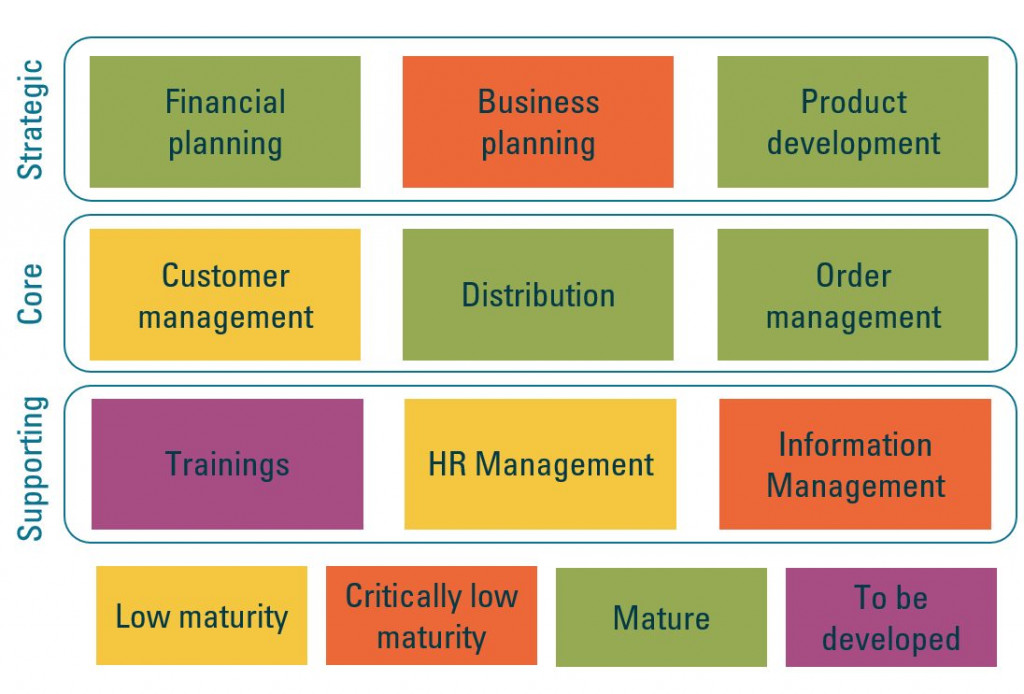
Unlocking Organizational Potential: The Power of Business Capability Heat Maps
Your organization's strategy is established, but its execution lags because of a gap between the strategy and the capabilities of your organization. A weak information landscape may be at the root of this problem. To tackle this challenge head-on, it is essential to first identify the organization's current state. There are several ways to do this. To assess an organization's information landscape and establish a clear roadmap for future success, we prefer using a Business Capability Heat Map.
From vision to execution
A digitization roadmap entails outlining a detailed plan for an information landscape that helps your organization translate long-term goals into tangible steps. By following a structured approach, you can monitor progress and adjust the course of your organization as needed. Before creating the roadmap, it is important to assess the organization’s current state, which can be done in a number of ways.
How do I map the current situation?
One common approach is to map all business processes using process mapping and modeling. This method involves visualizing the processes in chronological order and assigning a clear ‘owner’ to each process. Another approach is to create an overview of all software applications used within an organization, including their relationships and integrations.
Both methods provide a time-based view of the organization’s processes and applications – it is a snapshot. This view can create problems when you need to change processes or track the view over time. That’s why we prefer to work with business capabilities.
What are business capabilities?
A business capability represents the essence of what your organization does to fulfill its strategic objectives. Business capabilities describe what the organization does, rather than delving into the specifics of how or who does it. Examples include HR management, customer relationship management, and product development. These capabilities are stable over time, mutually exclusive, and transcend departments or process/application owners. By focusing on the ‘what’ rather than the ‘who’ or ‘how’, the approach fosters a neutral outcome, creating more support for the process. This approach allows for open communication and separates emotions from the evaluation of the organization’s strengths and weaknesses.
Identifying the capabilities – depending on the complexity of the organization – can be challenging. For a smooth start, we typically use reference models on which we plot the organization in question. We then validate this outline in an interactive workshop with relevant stakeholders within the organization.
What is a business capability map?
You create a business capability map by identifying and visualizing an organization’s capabilities. Visualizing can be done in different ways, depending on the needs of an organization and the complexity of the capabilities. We now zoom in on Heat Map visualization.
What is a business capability heat map?
A heat map offers a visual representation of business capabilities based on criteria such as effectiveness, efficiency, strategic relevance, or maturity. The performance per capability is then displayed using color codes. For example, green represents strong performance, yellow represents average performance, and red represents weak performance. Understanding the root cause of good or poor capability performance is critical for the creation of the digitization roadmap. To achieve strategic goals, it is best to classify causes as process, application, or data-related. Weak capabilities may result from inefficient processes, inappropriate applications, or unused data.
Simplified example of a business capability heat map:

By clearly defining and classifying these factors, organizations can tailor their responses to capitalize on opportunities and mitigate threats within each capability. The heat map provides immediate insight into areas of organizational excellence and areas that require improvement. Additionally, the heat map can assist in prioritizing steps. Therefore, the heat map serves as the foundation for your organization’s strategic roadmap.
Ready for the next step?
Ready to embark on this journey towards achieving your strategic goals through a digitalization roadmap? Let us support you! Schedule an introductory meeting here or leave your details below and we will get back to you.
Thank you for your message!
We will get back to you as soon as possible.

First step in application landscape cleanup
Your company is growing fast. You are breaking sales records and taking over other companies. Together with your team, you celebrate these victories and are positive about the future. However, you know that this growth comes with challenges. For instance, a rapidly expanding application landscape that is hard to stay in control of.

Five steps towards a supported data strategy
The transition to cloud applications is making unprecedented progress in many organizations. This comes with its challenges – for example, valuable data is regularly lost because it is “hidden” in different places in an organization and it is not communicated effectively between departments. This way, the available data within an organization is not used and eventually, valuable data is lost. A missed opportunity.